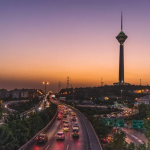The best time for Damavand mountain climbing in Iran is from mid-June until mid-September. The hot and steady weather of summer makes climbing Mount Damavand the most ideal time during the year.
Climbers are drawn to Mount Damavand, Iran’s highest peak at 5,610 meters, because it presents an exciting yet manageable high-altitude challenge.
Summer Season: Mid-June to Mid-September
Mid-June to mid-September is the best time of the year to ascend Mount Damavand, with July and August being the best months. The mountain is perfect for climbers of all ability levels during this time of year because of the generally steady weather, warmer temperatures and decreased chance of violent storms.
Favorable Weather Conditions
Higher elevations have summertime temperatures between 0°C and 10°C, while lower elevations experience midday temperatures between 15°C and 25°C. Although the wind chill may make it feel colder, there is less snow, which makes the paths easier to navigate, especially on the well-traveled southern route.
Frequent clear skies support safer summit attempts and offer breathtaking views of the Alborz range. Climbers have enough time to ascend and descend without haste because July may have up to 14 hours of daylight.
Logistical Support and Assistance
Lone explorers and organized groups can make use of base camps like Polour and Reineh in the summer due to their full functionality. Local guides and mule services are great options for those who want help with transporting their gear.
Keep in mind that due to the popularity of this time of the year, you may face more crowded shelters and busier paths, especially at Bargah Sevom (4,200m). Reservations for lodging or camping areas should be made in advance to secure a spot.
Tips for a Calmer and Quieter Experience
For those seeking solitude, early June or late August can offer less-crowded trails, though weather stability may be slightly less predictable. Climbers need to be alerted no matter when they are in the summer windows. Checking weather forecasts and preparing for freezing nights over 4 Kilometers is important due to unpredictable weather changes.
You may experience altitude sickness due to Damavand’s steep slopes. But, you can lessen it by staying at intermediate camps for a day or two.
When to Avoid Climbing Mount Damavand
It is important to know when and in which conditions it is not suitable to climb Mount Damavand due to life-threatening risk factors. Here are more details regarding this matter:
Off-Season Challenges: Late September to Early June
Although highly experienced mountaineers can technically climb Mount Damavand all year round, most climbers are put off by the significant risks that come with the off-season, which runs from late September to early June. These months should be avoided unless you are an expert with specific equipment and training.
Winter Conditions: October to May
Damavand has tough winter weather from October to May. At higher elevations, temperatures can drop to -30°C or below, and the cold is made worse by strong winds. Trails get obscured by blizzards and thick snowfall, making it more likely that one may become lost or stranded.
With ice and substantial snow, the southern path becomes dangerous and requires highly skilled ice climbing and navigating. Serious hazards include avalanches and during storms, low visibility can make rescue efforts all but possible.
Spring Conditions: March to Early June
Spring may be a misleading time of the year due to its beautiful appeal and warmer weather. But you have to be aware of muddy slip hazards and loose rocks in unstable terrain caused by snowmelt. Avalanches and rockfalls can occur due to the melting snow, especially on steeper areas and sudden storms are still frequent.
Even in late spring, the weather may change suddenly, making ascents more difficult. Rain at lower elevations might transition to snow at higher elevations.
Autumn Conditions: Late September to November
Due to ice formation on trails and a drop in temperature, autumn is just as dangerous. Safe climbing time is limited due to reduced daylight hours and early snowstorms can be a problem. Many base camp facilities are costly, causing problems related to logistics and emergencies.
Physical and Mental Demands
Climbing during the off-season causes more physical and mental challenges. Extreme cold increases the chance of frostbite and altitude sickness. Also, fewer climbers are ascending, so you can’t rely on people that much during emergencies. If you want a safer and more enjoyable climbing experience, make sure to avoid off-season altogether.
















